The American Tourists by Donald Strawn (best books to read non fiction .TXT) 📖
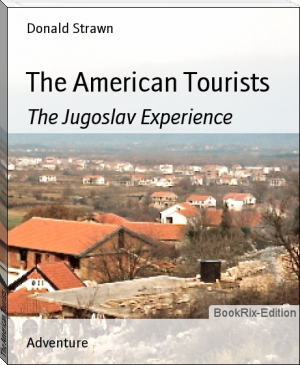
- Author: Donald Strawn
Book online «The American Tourists by Donald Strawn (best books to read non fiction .TXT) 📖». Author Donald Strawn
the state of their disrepair. Both Zagreb and Sarajevo have many fine old buildings that are
crumbling into ruins before our eyes, but here in Sarajevo they werenʼt even bothering to pick up the pieces!
They have so many old landmarks that could be so much more beautiful if they were maintained more often.
Inflation, like a roaring lion, is consuming the peopleʼs money right in their pockets. The signs of poverty are everywhere. New buildings are springing up everywhere, but little seems to be done to salvage what already exists. Huge, new office buildings sit alongside buildings whose walls have gaping holes and missing windows, but still
sheltering human inhabitants. Not too different from our cities where the older parts get abandoned in favor of urban growth.
On December 13, we set out with Nina and Miro on a “business” trip, that was mostly for our sightseeing. We stopped for a quick tour of his hometown, Mostar.
The Old Town was very interesting. One delightful, small shop was occupied by a woodcarver who is supported by the town. His works are not for sale, but are shown in exhibitions and some are given away by the “city fathers,” to visiting dignitaries.
His unusual carvings are done mostly from tree roots, most of which have grown around limestone boulders. The rocks then, are incorporated into the the carvings. After the girls had walked on to the
next shop, he took Miro and me into his loft to see 20 or more carvings on display up there.
On the way back through town we stopped at the home of two of Ninaʼs friends, Tanja and her sister, Mitzi. Their parents invited us in for awhile, then we went back to old-town Mostar. I wanted to take
Evelyn and my camera back to the woodcarverʼs shop. I also wanted her to see the awesome carvings upstairs. He seemed very pleased that we took the time to come back and take pictures of his work.
“I see you have a drawing board up here, Evelyn addressed him, “Do you draw everything before you carve it? she asked.
“Yes, I do. What is your name?” he asked. “Would you write it for me?”
She did and he proceeded to make a stylized charcoal portrait using the letters of her name. He then autographed it with his name and address.
The shop of the woodcarver, Milivoje Bokic
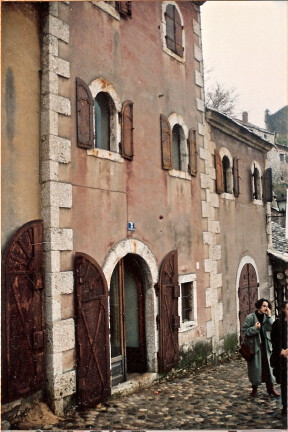
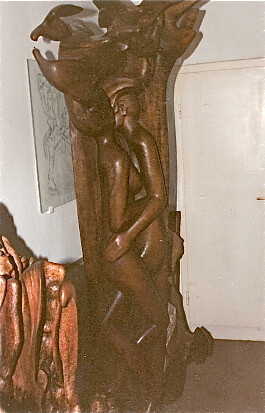
His carvings were made mostly from tree roots.
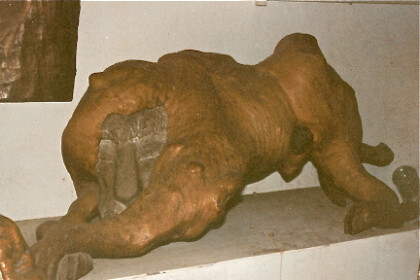
Most of them had in-grown rocks that were
incorporated into the sculptures.
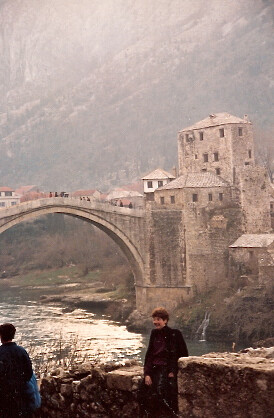
The old bridge of Mostar. Began in 1557 by the Turks took nine years to complete.
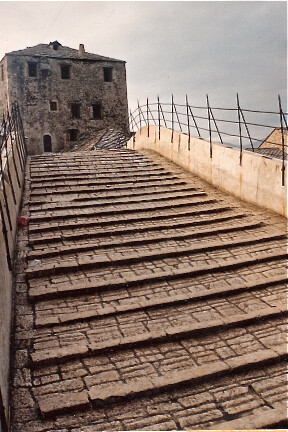
Probably the most photographed bridge in all of
Europe, it didn’t escape my lens either.
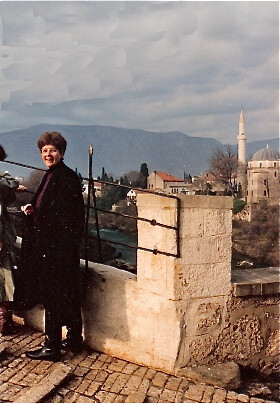
This tourist didn’t escape my lens either, although she tried.
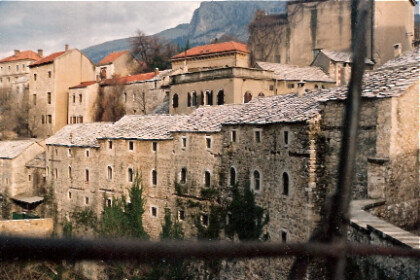
Mostar has its old as well as its new.
Below is the new aluminum and airplane factories.
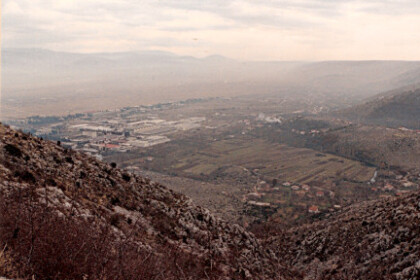
We left Mostar and set out again for Trebinje to spend the night with Miroʼs brother, Ranko and his daughter, Diana. Neither of them knew more than a few words of English. But we had a good time bridging the language barrier with parlor tricks and tall tales translated by Nina.
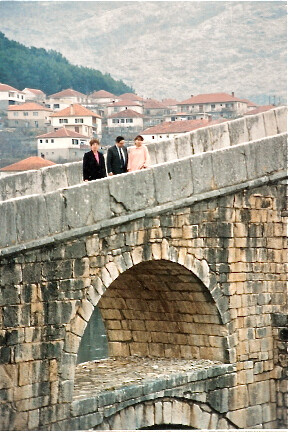
The old bridge at Trebinje.
This interesting old bridge was dismantled stone by stone in 1961 and reassembled 6 km downstream to make way for hydroelectric project.
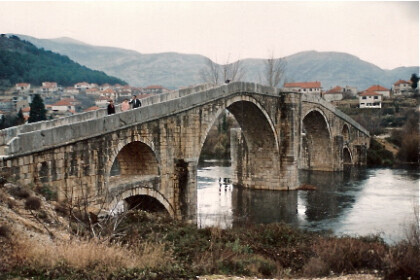
This is a view from the Trebinje bridge. Just beyond
these houses lies a garden area where Miro’s father
was shot by the “liberating” Italian soldiers in 1941.
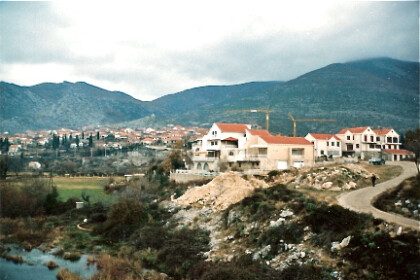
A newer village was built below this old ghost town on the hill.
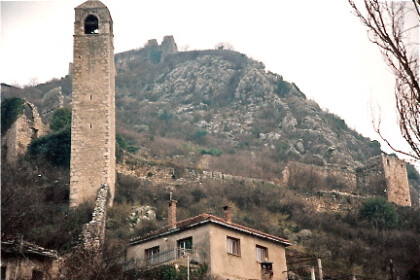
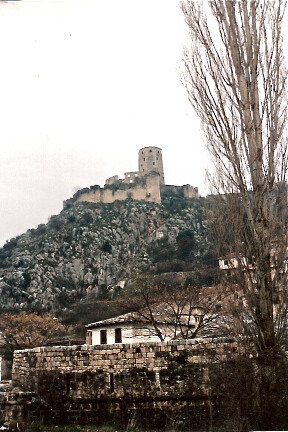
The ruins of old fortresses like this are quite common in this area.
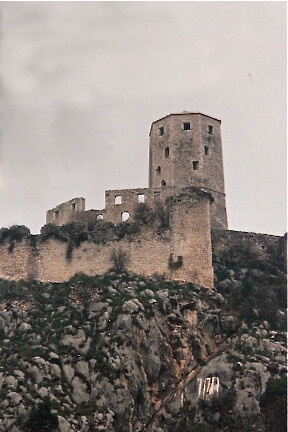
All of the roofing material in this village was either red-clay tile or carved slate like the one in the foreground.
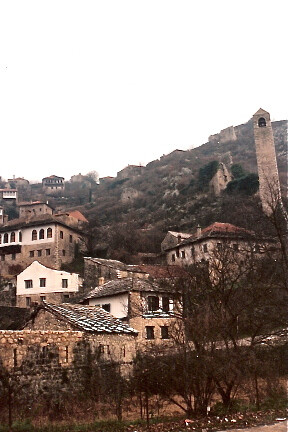
As a village grew during the Turkish era, each new section would have its own mosque. This one was unique. It had no PA system on the little walkway of the tower. It still had a real, live man walking around the tower platform calling out the prayers.
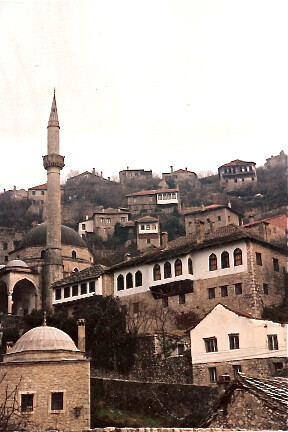
<<font;doradani>All throughout this area of Jugoslavia, not much vegetation grows on the hillsides. There are lots of rocks, a few scrubby trees and shrubs.
It reminds me a lot of pictures that Iʼve seen of the “Holy Lands.”
Someone in ancient times must have thought this area was valuable though, because there are rock fences running for miles in all directions, up hill and down, crossing valleys and creeks. Some are in
low areas and circular with the area inside picked clean to form gardens, orchards, and corrals.
Some of the fences seem to start nowhere in particular, and wander off to nowhere in particular, or end abruptly part way up a hillside. The Great wall of China has nothing on these walls except size.
We passed a number of abandoned stone buildings. Some appeared to be fortresses built on a prominent viewpoint above a village. Some villages were occupied, some were not. Most of these country homes are built entirely of stones... even the shingles! All of them were surrounded by stone
walls. I couldnʼt think of a better building material for this area, could you?
The road to Madugorje was particularly desolate. So the first sight of the little valley came as a quite a shock. The houses were no longer built of natural stone blending in with the scenery, but stark white stucco with red clay tile roofs. And nearly ALL of them were BIG villas.
On June 24, 1981, so the legend goes, six young people had a mountaintop experience in which the Virgin Mary appeared to them and asked them to pray for world peace. A miraculous event to be sure, but that was not the end of it. She has been appearing to at least four of them every day since that time.
But the real miracle, it seems to me, is what has happened to the tourist trade in this sleepy little sheep town out in the middle of nowhere, since the word has gotten out. People come by the bus loads every day from all over the world.
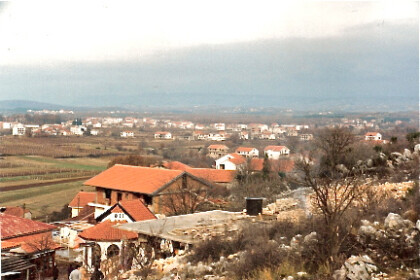
The road past all these villas stops and the trail starts here.
This view is looking across the valley to the Hill of the Cross.
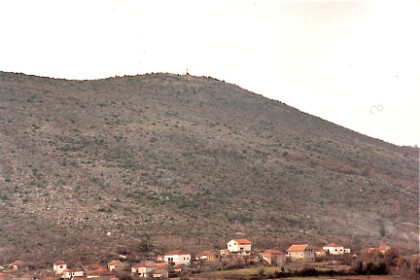
The pathway up the hill is marked with these brass
“stations” depicting the life of Mary. The appearing of the angel to Mary is, as far as I traveled... revealing my rapt attention to legend?
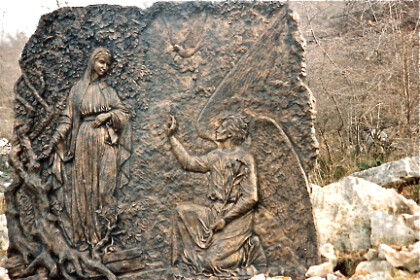
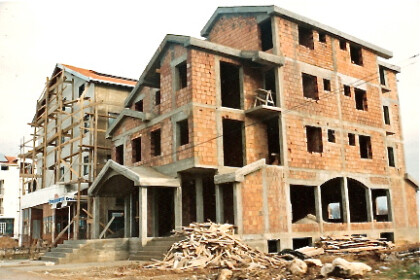
These villas are spreading across the valley like a
contagious disease, to area accommodates the 80-100
thousand pilgrims per year from all over the world.
An OSHA approved scaffolding, I’m sure!
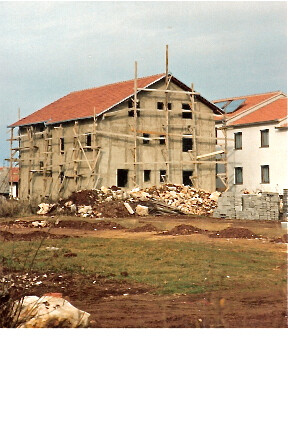
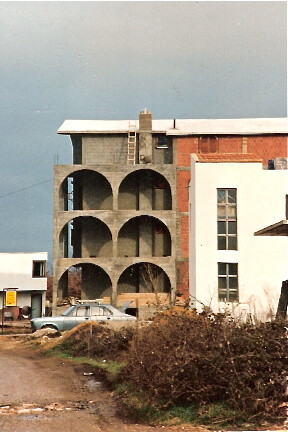
A lot of arched balconies face the famous Hill of the Apparitions, or Krizevac, the Hill of the Cross.
Friday morning we set out for Dubrovnik. One first sights this old town when crossing a mountain pass of several thousand feet and about 7 miles away. The descent is breathtaking!
The city is composed of an old fortress with waves pounding the walls, and the newer part that stretches up the coastline for several miles.
The fortress is laid out in a very orderly manner. The main street bisects the fort with large shops on either side. A block away on either side and running parallel are smaller streets and smaller shops. Each parallel street is a little higher elevation than the one closer to main street. As one walks up these side streets they get narrower,
becoming more like our sidewalks. The steps terrace every few yards at a narrow winding staircase as they ascend to the summit of the wall.
It seems amazing that people are actually living here in this ancient part of town. Not only that, but they still hang their underwear over the
street to dry, and live their lives and raising their kids much the same as they did 1,500 years ago.
In the city square is the large “Statue of Honor and Shame.” It is a likeness of the Patron Saint of the city. It was before this statue that the names of the honored citizens were read. On the backside is a timber to which were tied the undesirables and thieves. The good people of the town would file by hurling curses and spit upon them.
Leaving the fortress, we continued up the coast about 5 minutes to see some of the resort parts of the town. The whole place was deserted, except for a few maintenance people.
Thousands of rooms were waiting vacant, just waiting to entertain the tourists. Unfortunately, if the tourist donʼt come, and the politicians
donʼt want them, then nobody gets them and they sit idle.
The view approaching Dubrovnik is like that from an airplane. Unlike an airplane ride though, you experience all the thrills of hundreds of nervous drivers, big trucks, little cars, and narrow roads. One “tops the pass” at several thousand feet, then drops to sea level in less than ten miles. Miro was kind enough to stop every few minutes so we could enjoy the view without us having to worry about his driving, too.
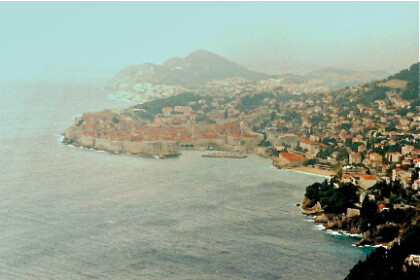
“Don! Your camera snaps that way!” flustered Nina.
Guess what? It snaps both ways!
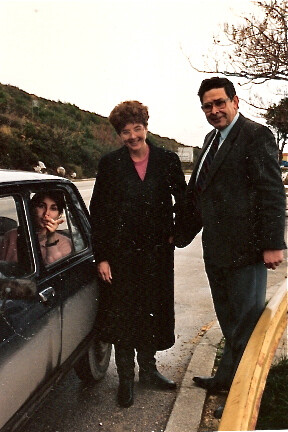
Stone fences like these were in the strangest places. Some were enclosures, others were straight and went on for miles.
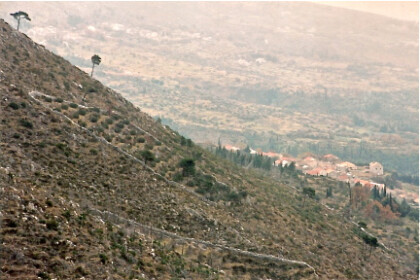
A drawbridge lowers to let friendly folk enter through these arches.
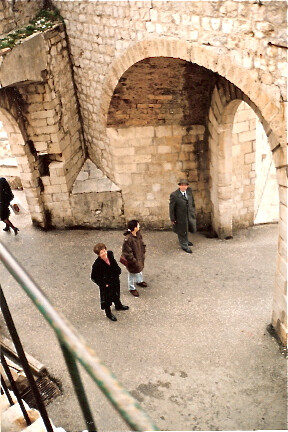
One of several towers placed at strategic points around the walls.
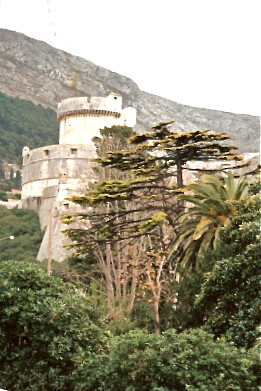
From behind the bars one feels secure enough for the times in which it was built.
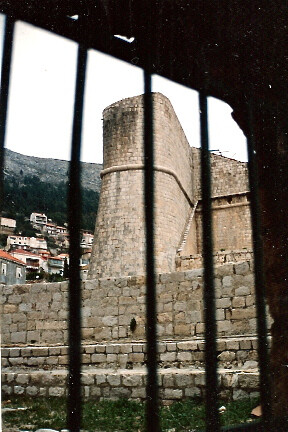
Waves have beat upon this rocky fortress for nearly 2,000 years and it remains solid still.
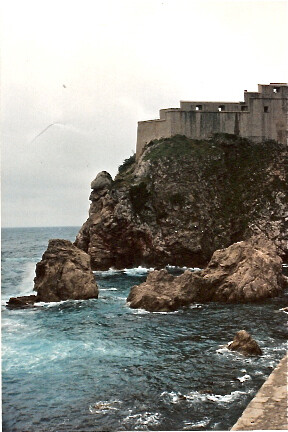
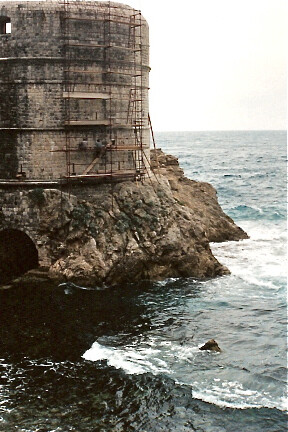
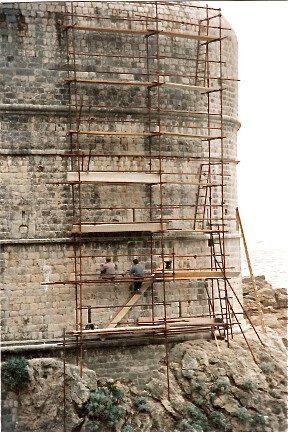
The hungry Adriatic Sea awaits a careless mistake.
Masons were engrossed in re-grouting the stonework.
These are the “streets” ascending the wall from inside the fortress.
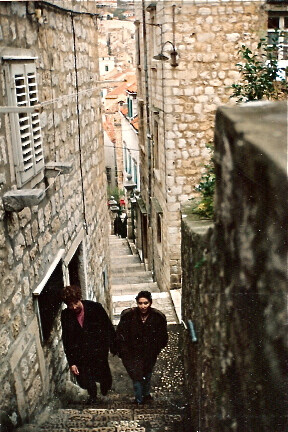
A temporary construction bridge. They were remodeling a large assembly hall
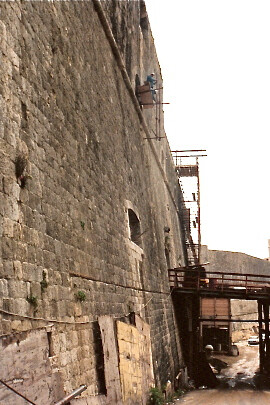
The fortress nearly surrounds this snug little harbor
.
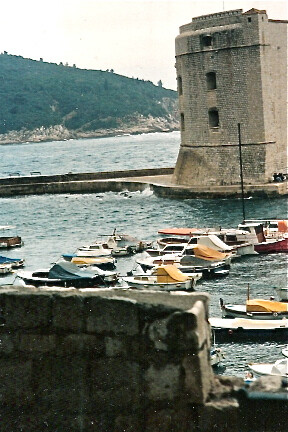
This monastery patio is bordered on one side by an apothecary that has been in continuous use since it was started in the 4th century. Today, however, it is staffed by this friendly druggist.
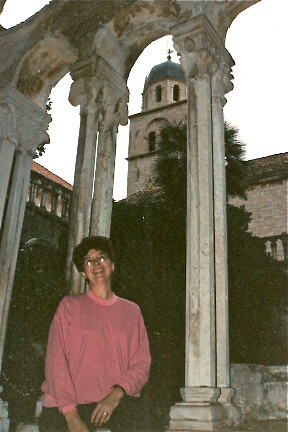
When we got back “home” Enka took us
 Nowadays a big variety of genres are exist. In our electronic library you can choose any book that suits your mood, request and purpose. This website is full of free ebooks. Reading online is very popular and become mainstream. This website can provoke you to be smarter than anyone. You can read between work breaks, in public transport, in cafes over a cup of coffee and cheesecake.
Nowadays a big variety of genres are exist. In our electronic library you can choose any book that suits your mood, request and purpose. This website is full of free ebooks. Reading online is very popular and become mainstream. This website can provoke you to be smarter than anyone. You can read between work breaks, in public transport, in cafes over a cup of coffee and cheesecake.
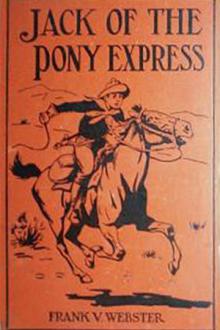



Comments (0)